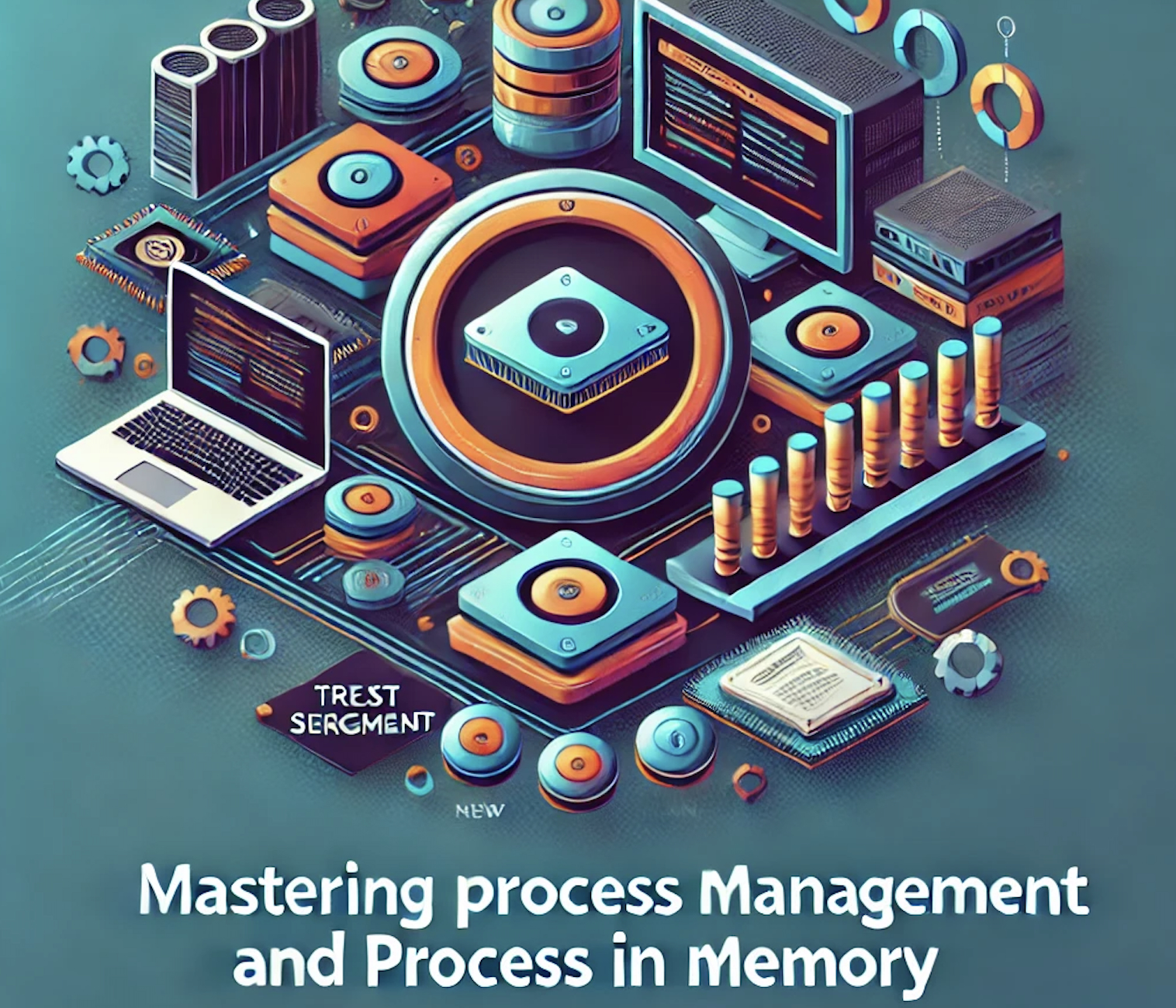Mastering Process Management and Process in Memory
Introduction
Process management and process in memory are fundamental concepts in operating systems. They are crucial for efficient and effective system performance. This comprehensive guide will delve into these topics, providing detailed explanations, practical applications, and real-world examples. Whether you’re a computer science student, a professional, or an enthusiast, this guide will enhance your understanding and proficiency in these essential areas.
What is Process Management?
Process management is the act of managing the execution of processes within an operating system. A process is an instance of a program that is being executed. When a program runs, it becomes a process, which is a dynamic entity that occupies memory and utilizes system resources.
Key Functions of Process Management:
- Process Scheduling:
- Manages the order in which processes are executed by the CPU.
- Uses algorithms to decide which process runs at a given time.
- Process Creation and Termination:
- Handles the creation of new processes and the termination of existing ones.
- Process State Management:
- Maintains the state of each process (e.g., running, waiting, blocked).
- Process Synchronization:
- Ensures that processes work together correctly when accessing shared resources.
- Inter-process Communication (IPC):
- Manages communication between processes to share data and information.
Process Lifecycle:
A process goes through several states during its lifecycle:
- New: The process is being created.
- Ready: The process is ready to run but is waiting for CPU time.
- Running: The process is currently being executed by the CPU.
- Waiting: The process is waiting for some event to occur (e.g., I/O completion).
- Terminated: The process has finished execution.
Practical Application:
Imagine a web server handling multiple client requests. Each request is handled by a separate process. Process management ensures that each request is processed efficiently, balancing the load and optimizing resource utilization.
Process Scheduling
Process scheduling is a crucial component of process management. It determines which processes run at a given time and for how long. Scheduling algorithms play a vital role in this process.
Types of Scheduling Algorithms:
- First-Come, First-Served (FCFS):
- Processes are executed in the order they arrive.
- Simple but can lead to poor performance (e.g., convoy effect).
- Shortest Job Next (SJN):
- Executes the shortest process next.
- Can lead to starvation of longer processes.
- Priority Scheduling:
- Processes are assigned priorities, and the highest priority process runs next.
- Can lead to starvation of lower priority processes.
- Round Robin (RR):
- Each process gets a fixed time slice (quantum) to run.
- Fair and prevents starvation.
- Multilevel Queue Scheduling:
- Processes are divided into different queues based on priority or type.
- Each queue has its own scheduling algorithm.
Example:
In a multi-user operating system, Round Robin scheduling ensures that each user gets a fair share of CPU time, improving system responsiveness and user satisfaction.
Process Synchronization
Process synchronization is essential when multiple processes access shared resources. It ensures that processes do not interfere with each other, preventing data inconsistency and race conditions.
Synchronization Mechanisms:
- Mutexes:
- Mutual exclusion objects that prevent multiple processes from accessing a resource simultaneously.
- Semaphores:
- Signaling mechanisms that control access to resources.
- Monitors:
- High-level synchronization constructs that manage access to shared data.
- Locks:
- Simple mechanisms to ensure exclusive access to resources.
Practical Application:
Consider a banking system where multiple transactions are processed concurrently. Process synchronization ensures that account balances are updated correctly, preventing inconsistencies and errors.
Inter-process Communication (IPC)
Inter-process communication allows processes to exchange data and information. It is crucial for the coordination and cooperation of processes.
IPC Mechanisms:
- Pipes:
- Simple, unidirectional communication channels between processes.
- Message Queues:
- Allow processes to send and receive messages.
- Shared Memory:
- Processes share a common memory space for communication.
- Sockets:
- Enable communication between processes over a network.
Example:
In a client-server architecture, IPC mechanisms like sockets facilitate communication between the client and server processes, enabling data exchange and service delivery.
What is Process in Memory?
A process in memory refers to the data structures and memory areas that a process occupies while it is being executed. Understanding how a process is represented in memory is crucial for efficient memory management.
Memory Layout of a Process:
- Text Segment:
- Contains the executable code of the program.
- Data Segment:
- Contains global and static variables.
- Heap:
- Dynamic memory area for allocating memory during runtime.
- Stack:
- Stores local variables, function parameters, and return addresses.
Process Control Block (PCB):
The Process Control Block (PCB) is a data structure maintained by the operating system for each process. It contains essential information about the process, including:
- Process ID (PID)
- Process state
- Program counter
- CPU registers
- Memory management information
- Accounting information
- I/O status information
Practical Application:
In a multitasking environment, the operating system uses the PCB to manage context switching between processes. This ensures that each process continues execution from where it left off, maintaining system stability and efficiency.
Memory Management in Process Management
Memory management is a critical aspect of process management. It involves allocating and deallocating memory to processes and ensuring efficient memory utilization.
Memory Allocation Techniques:
- Fixed Partitioning:
- Divides memory into fixed-sized partitions.
- Simple but can lead to internal fragmentation.
- Dynamic Partitioning:
- Allocates memory dynamically based on process requirements.
- Reduces fragmentation but requires complex management.
- Paging:
- Divides memory into fixed-sized pages.
- Allows efficient memory allocation and reduces fragmentation.
- Segmentation:
- Divides memory into variable-sized segments based on logical divisions.
- Provides flexibility and efficient memory usage.
Virtual Memory:
Virtual memory is a memory management technique that allows the execution of processes that may not be completely in the main memory. It uses disk space to extend the available memory, enabling efficient multitasking and resource utilization.
Page Replacement Algorithms:
- First-In, First-Out (FIFO):
- Replaces the oldest page in memory.
- Least Recently Used (LRU):
- Replaces the least recently used page.
- Optimal Page Replacement:
- Replaces the page that will not be used for the longest time.
- Clock Algorithm:
- Uses a circular buffer to track page usage.
Example:
In modern operating systems, virtual memory allows users to run multiple applications simultaneously without running out of physical memory. This improves system performance and user experience.
Practical Examples of Process Management and Memory Management
Example 1: Web Browsers
Web browsers like Google Chrome and Mozilla Firefox use process management to handle multiple tabs and extensions. Each tab runs as a separate process, ensuring that a crash in one tab does not affect the others. Memory management techniques like paging and virtual memory enable efficient use of system resources, allowing users to open numerous tabs without performance degradation.
Example 2: Operating Systems
Operating systems like Windows, macOS, and Linux use process scheduling algorithms to manage the execution of multiple applications. For instance, Round Robin scheduling ensures that all running applications get a fair share of CPU time. Memory management techniques like segmentation and paging ensure that applications run smoothly, even with limited physical memory.
Example 3: Database Management Systems
Database management systems (DBMS) like MySQL and PostgreSQL use process synchronization mechanisms to handle concurrent transactions. Mutexes and semaphores ensure that multiple transactions can access the database without causing data inconsistencies. Inter-process communication mechanisms like shared memory enable efficient data exchange between different components of the DBMS.
Conclusion
Process management and process in memory are fundamental concepts in operating systems. They ensure efficient resource utilization, system stability, and optimal performance. Understanding these concepts is crucial for computer science students, IT professionals, and anyone interested in the inner workings of operating systems.
At DigiiMento Education, we specialize in training students for competitive exams like GATE, UGC NET, and PGT in Computer Science and IT. Our courses provide in-depth knowledge and practical skills, ensuring our students excel in their exams and careers.
For more information and to enroll in our courses, visit our website at www.Digiimento.com. You can also reach us at 9821876104 or 9821876102.
Subscribe to Our YouTube Channels:
Explore our courses and join our community for comprehensive learning and success in your exams.
Tag:computer science, CPU Scheduling, DigiiMento Education, GATE Preparation, Himanshu Kaushik, IT Competitive Exams, IT Training, Memory Management, Operating Systems, OS Process Management, PGT Computer Science, Practical Applications, Process in Memory, Process Management, Process Scheduling, Process States, Real-world Examples, UGC NET Computer Science




